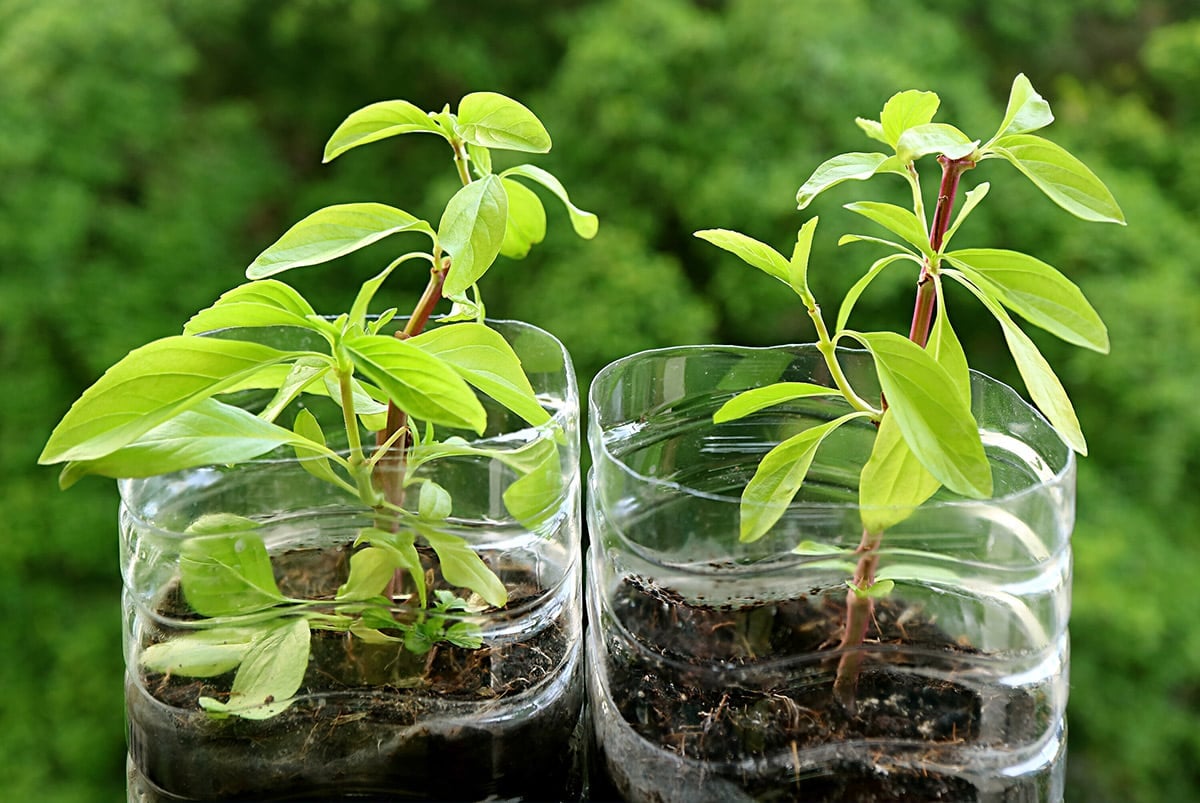Thai Basil
When a western chef in his kitchen, experiences Asian cuisine, the first thing to grab is Thai Basil. It is a widely used cultivar throughout Southeast Asia.
This member of “Mint Family” serves the taste and aroma of Vietnamese, Thai, Lao, and Cambodian cuisines mostly. These lovely plants serve not only for culinary purposes but also adds beauty to your garden as an ornament.
Check out these other amazing herbs, Rosemary Benefits, Bay Laurel Tree, and Cumin Nutrition And Benefits.
What Does Thai Basil Look Like?
Thai basil (Ocimum basilicum) has purple-veined leaves with dark, shiny olive green background. This perennial basil is as high as 12 to 18 inches that is about 30.5cm to 45.5cms. The leaves of Thai basil are 1 to 2 inches long which is about 2.5cm to 5cms.
It is often confused with the pleasing aroma of sweet basil but its appearance can be differentiated by that of sweet basil easily. Sweet basil has glossy plump leaves that are different from the matte pointed leaves of Thai basil.
As the summer progresses, the plant’s flower with purple bract and pinkish-purple petals. It is often suggested to pluck those flowers for growing your Thai basil taller. Also using these flowers in your cuisine will give the similar taste and aroma of Thai basil leaves.
What Does Thai Basil Taste Like?
Thai basil scents like an anise-seed with the aroma of sweet basil. The lack of slight spiciness in sweet basil is what makes it distinct from Thai basil. Its anise aroma declares it as a good friend of warm spice when used as a dried herb.
Its taste and aroma resemble that of licorice and clove but is different from western strains bearing similar names.
Where to Get Thai Basil Plant?
First things first, if you are looking forward to planting a Thai basil plant. Your first concern is going to be where you can find the plants to grab and go!
So for this purpose, I recommend you to check out your local nursery. In case if they are out of stock they can arrange for it to be ordered and you to pick it up later with no extra expense on you.
The other place to find such herbs is specialty kitchen garden centers. Believe me, they are good to go for every kitchen garden product. Just find one near you and you are halfway done.
If still unable to find the plant then fret not, as you can start with the seed as well. but with seeds, you have to be more patient and careful.
As the plant prefers tropical, sub-tropical climates but you can grow it in warm months in cold temperate climates or arid/semi-arid temperatures when frost chances are low or none.
Despite the variety, Basils are easy to grow and can give better results with even low maintenance. As it is a delicate native of more humid regions, it can tolerate more moisture than other herbs of his family.

How to Grow a Thai Basil Plant?
I am providing you with steps to follow for your ease in growing such an ornamental garden piece and a kitchen’s essential herb.
- It is an annual plant so it’s better to harvest it regularly.
- If you are looking forward to growing this delicate herb in pots then go for a self-watering pot initially.
- A premium organic potting mix will work well if it has Australian standard ticks on it for growing and grooming within pots.
- Its moisture at an optimal level will be well-maintained in a self-watering pot.
- If you are planning to grow it indoors then plant it in front of a sunny windowsill.
- If you are planning to grow it outdoors, make sure the sunlight reaches it properly or it seems partly shady under sunlight.
- You can grow it in a garden bed as well, but you need to improve soil with compost and aged manure prior to planting.
- While these plants grow young, they need protection against snails and slugs
- In order to build a plant’s resistance against pests and frosts, you can apply seaweed solution. This will also improve plant vigor as well as resistance.
How to Care for Thai Basil Plant?
- Freely draining pots or self-watering pots help the moisture level optimize properly.
- If you are a gardening person you must be aware of the saying “under-watering is better than over-watering”.
Pro Tip: you can check that by digging your finger in soil for an inch or a half, if it is damp with soil then don’t water. And if not damped then water it.
- Follow proper watering techniques and try to get it from the base of the plant. As the Basil plant does not like to be watered on top of its peak or on leaves.
Fact: Watering plants on their leaves can encourage various issues like all kinds of fungi growth and other related problems.
- 6-8 hours of light is good for your Thai basil so it’s better to plant it accordingly. Fix a place by checking the direction of sunlight it faces in the day. As your Thai Basil plant loves summer, heat, and sun.
- Fertilizers and compost both if arranged organic work wonders.
Pro Tip: consult specialty gardening centers for better composts and fertilizers as they have knowledgeable experts to provide you with several options.
- Harvest on regular basis.
- If you want to avoid your plant from growing seeds right now just remove the spikes. This will delay the process of seeding in the basil plant.
- This annual herb needs to be cut down at the end of the growing season.
- Insecticides spray that suits your plant can help if faced with an aphid problem.it will prevent further problems and damages occurring to the plant.
- Best fertilizers can be those rich in nutrients especially fish emulsion and seaweed solution. Apply these during the season of their active growth.
Uses of Thai Basil Plants
Done with harvesting Thai basil? Wondering what now? Well, there’s a lot to do with it. Hang on!
- First and foremost, use this basil plant fresh for adding aroma and delicate taste to your southeast Asian cuisines. Check out Thai Basil Soycurls.
- There are bulks of recipes available online for bringing Thai basil into use. Namely, you can make tea with it, it goes well infused with oil.
- Thai basil with mint and ice is a well-known iced tea recipe.
- There are mainly three ways to go with using and preserving the Thai basil. Use it fresh right after harvesting or chop it up and dry it (you can use a food processor for chopping) and use it as a partner of warm spice. Or preserve it in an ice-cubes tray soaked in water for later use.
- The frozen cubes can be transferred to sealing bags and can be consumed for up to 2months.
- Thai basil is not just a part of your culinary and cuisines rather it can serve as a therapy. Yeah, you guessed right! “Aromatherapy”. Wondering how? Just bruise the leaves and inhale their aroma and relax!
- If you had a hectic, long, stressful working day and you want a massage and relaxation therapy. You can have one right at your home that also with fragrance and in-born aroma. Just bruise few leaves of Thai basil and rub them under your eyes and forehead and relax with inhaling the scent of basil herb.
- Thai basil flowers serve the best toppings over a simple salad or a pizza due to their mild flavor and beautiful color appearance. ( better used dried for serving as a topping)

Decorative side of Thai Basil Plant
It’s an ornamental decorative piece to your garden. It’s a multi-purpose plant that can be eaten, decorated, or used as therapy or work wonders.
It adds fragrance and unique beauty to bouquets. Just cut the plant’s top right about the length of the vessel you have and put the flower top of Thai basil into vessels.
A complete bouquet of just Thai basil flowers is enough to beautify your flowery present. Otherwise, you can add a variety of flowers along with it into your vessel or bouquet.
As they say the taller the flower, the filler the bouquet. Thai Basil’s tall spires are a great composition for bouquets.
What to grow beside the Thai Basil plant?
Planting rosemary along the Thai basil plant works well as they are always happy in sharing drained soil, fertilization, and water.
Tip: You can purchase rosemary from the same nursery while buying Thai basil and they are good to go for planting together and sharing their mutual space.
Fun Facts related to Thai Basil Plant
- Thai basil may be good to relieve indigestion. Read More.
Other Related Articles
- Golden Honeydew
- Winter Melon
- Chocho
- Sorghum Nutrition
- Aloe Vera Benefits
- Medjool Date Nutrition And Benefits
- Kiwi Nutrition And Benefits
- Yellow Yam
Concluding with these fun facts and pretty informative essentials to know about Thai basil plant. I wonder if you got impressed with the uses and beautiful appearance of this herb from the Mint family. I know you did! So Happy Gardening!
If you enjoyed this post and would love to see more, join me on Youtube, Instagram, Facebook & Twitter!
Get discounted copies of my cookbook here.
Fortunately, because of the Ads on our website, readers and subscribers of Healthier Steps are sponsoring many underprivileged families.







I first knew about basil in 2017….it is very good to have around
I will definitely go all out to propagate the Thai basil plant because of its benefits ie , adding aroma and sweetness to Food
This is very informative. Thanks for sharing.